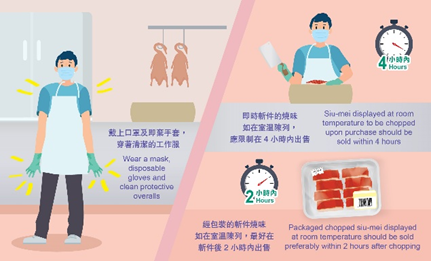
Feature Article
Microbiological Quality of Siu-mei After Prolonged Storage at Ambient Temperature
Figure: Safe preparation and display of siu-mei
In July 2021, a number of food poisoning outbreaks involving a local siu-mei shop occurred in which the victims developed symptoms a few hours after consuming take-away food purchased from the premises. As found by the investigating officers, there were excessive coagulase-positive staphylococci in the poached chicken and siu-mei samples collected from the restaurant. Among coagulase-positive staphylococci, Staphylococcus aureus (S. aureus) is the predominant pathogen that causes food poisoning. In the following, we will discuss how S. aureus is spread to siu-mei and consider the related preventive measures.
Risk of S. Aureus Contamination Due to Improper Handling and Storage of Food
In Hong Kong, siu-mei and poached chicken are common vehicles of bacterial contamination associated with staphylococcal food poisoning. It is often attributable to manual handling and prolonged display of food at ambient temperature. S. aureus, a bacterium commonly found on human’s hair, skin, nasal cavity, throat and wounds, can contaminate food via food handlers’ hands, especially when food is handled subsequent to cooking. As cooking eliminates other microorganisms competing for growth, it creates a favourable environment for S. aureus to proliferate. Coupled with prolonged food storage at room temperature, S. aureus can grow exponentially and produce heat-resistant toxins. Hence, people can still be poisoned from consumption of incriminated food even if the food is re-heated. In fact, it is not uncommon to see some food businesses hanging and exhibiting siu-mei in a showcase before the storefront at room temperature for a few hours. This calls into question whether it is a proper way to display food from the perspective of food safety.
Hygienic Handling and Display of Siu-mei
As noted in a study conducted by the Centre for Food Safety (CFS), the traditional practice of displaying siu-mei for a few hours before chopping is unlikely to cause microbiological concerns. The study assessed changes in the microbiological quality of siu-mei (particularly roasted meats) kept at room temperature for up to eight hours. It is revealed that an intact piece of uncut siu-mei does not favour bacterial growth, possibly due to the protective effects of surface drying and seasoning. That said, food handlers should follow good hygiene practices to minimise food contamination by bacteria, including the pathogenic ones. In the above study, all siu-mei samples collected from three out of the eight participating shops were detected with low-level S. aureus. This implies that S. aureus can cause widespread contamination at the shop level. Therefore, it is important to maintain a high standard of personal hygiene and cleanliness throughout the process of siu-mei preparation.
It is noteworthy that chopping siu-mei for display can promote bacterial growth. The study shows that the total bacterial counts of chopped siu-mei, especially those wrapped in cling film, reached unsatisfactory levels after being left at room temperature for hours. It is possibly the result of (1) contamination of siu-mei during the chopping process; (2) an increase in surface area for bacteria to grow; (3) exposure of the protein-rich surface; and (4) retention of moisture in food that favours bacterial growth. Therefore, for siu-mei that are cut and packaged for display at room temperature, it is advisable to sell them within two hours and consumers should finish them as soon as possible.
Key Points to Note
- S. aureus is commonly found on body parts including the skin, the nose and wounds. It can contaminate siu-mei during the manual handling process, including chopping.
- Uncut siu-mei do not favour bacterial growth and hence can be displayed at room temperature for hours. That said, food handlers have to maintain personal and environmental hygiene to minimise cross-contamination.
- Chopped siu-mei, especially those in packaged form, provide a favourable environment for bacteria to proliferate. Cut siu-mei items should preferably be sold within two hours and consumed as soon as possible.
Advice to the Public
- Siu-mei chopped upon purchase should be consumed within four hours.
- For chopped and packaged siu-mei displayed in a showcase, consume them as soon as possible or keep them refrigerated after purchase.
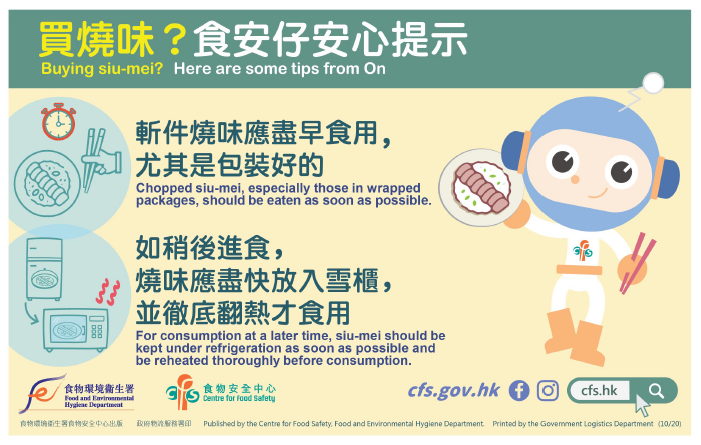
Mascot ON in Lesson
Nitrogen – A Packaging Gas and More
Have you ever wondered why the bags of potato chips or shrimp crackers are always inflated? Why do the potato chips inside get softened and, occasionally, rancid quickly once the package is opened, even before the “best before” date has passed? Packaging gases can be considered a food additive with unique functions in food processing which slows down food spoilage and improves the shelf life of food products effectively. This article will study the application of packaging gases in food products, as well as the science behind and its safety.
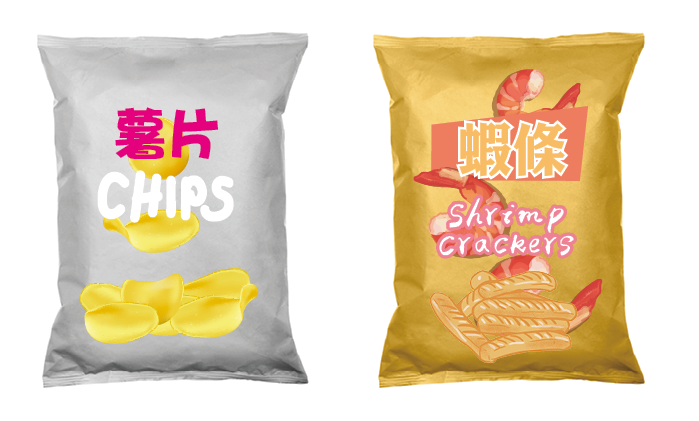
Figure: Food products in gas-filled bags
What Is a Packaging Gas?
Air contains approximately 78% nitrogen, 21% oxygen and a variable amount of moisture. When exposed to air, potato chips and some other foods absorb moisture and go stale and soggy quickly. Atmospheric oxygen also reacts with the unsaturated fatty acids present in foods, resulting in rancid off-flavours. Consequently, it is always a challenge faced by food manufacturers to preserve the quality of food products while prolonging their shelf life.
The use of packaging gases is an effective solution. A packaging gas is a gas introduced into the food package before, during or after it is filled with food to protect the food from oxidation or spoilage. Such gases include nitrogen, carbon dioxide and nitrous oxide. Nitrogen has long been used as a packaging gas in various food products including snacks, breakfast cereals, candies, bakery products, dried fruits and vegetables, and processed meat products.
Nitrogen Serves More Than a Packaging Gas
Nitrogen has found its way to the brewery and coffee industries where it is infused in beer or cold brew coffee to make “nitro beer” or “nitro brew”, giving the final product a richer and creamier mouthfeel.
How Does Nitrogen Work As a Packaging Gas?
Unlike the air we breathe every second, nitrogen used in food packaging contains very little oxygen and moisture. Nitrogen is inert (i.e. not reacting with any food components), odourless and tasteless. When nitrogen is introduced into a packaging bag, it drives out oxygen and any moisture present. By adding nitrogen to modify the internal atmosphere of the food package, we can preserve food quality, slow down spoilage and extend the shelf life of food products.
Nitrogen also inflates the packaging bag and protects the delicate food inside from being crushed during handling. However, the amount of nitrogen used should not be excessive. It should just be sufficient to provide the necessary protection and allow space for additional bag expansion to cope with pressure changes during food transportation and storage.
The food package must be low in gas permeability and tightly sealed to prevent nitrogen from escaping. Once we open the package, the food inside is exposed to atmospheric air containing oxygen and moisture. Without protection from an immediate and controlled environment, the food will be prone to dampening, spoilage and oxidation. Therefore, it is best to consume the food products as soon as possible once the package is opened.

Figure: Comparative composition of atmospheric air (left) and food-grade nitrogen (right)
Is Nitrogen Safe for Food Use?
Like other food additives, nitrogen has gone through rigorous safety assessment before it is ascertained as safe for food use. The Joint Food and Agriculture Organization/World Health Organization Expert Committee on Food Additives has evaluated the safety of food-grade nitrogen and considered that it is safe upon normal consumption when used in foods in accordance with the Good Manufacturing Practice.
What Is Food-grade Nitrogen?
Food-grade nitrogen has a high concentration of nitrogen (not less than 99%). In contrast, non-food-grade nitrogen may not achieve the intended functions and may contain impurities, thus not suitable for food use. As stipulated in the Public Health and Municipal Services Ordinance (Cap. 132), all foods for sale in Hong Kong must be fit for human consumption. Only food-grade nitrogen with high purity should be used in foods to ensure food safety and preserve food quality.
Always Keep Hands Clean and Cook Food Thoroughly

The CFS has stepped up precautionary testing measures to prevent the import of the COVID-19 virus through frozen foods. Up to now, over 14 000 samples of foods and their packaging have been collected for testing of the virus, with some samples of imported fish and their packaging tested with positive results. The fish stall involved had undergone deep cleansing and disinfection, and the market concerned was thoroughly cleansed.
The novel coronavirus is predominantly transmitted through droplets. The risk of acquiring the virus in our daily life through food packaging is very low, nor can the virus multiply in food or on food packaging. However, food or food packaging may be contaminated with the virus like any other objects or surfaces. Nonetheless, members of the public should not worry too much if they always observe personal, food and environmental hygiene, keep hands and utensils clean, and cook food thoroughly.
Contaminated hands play a significant role in facilitating indirect contact transmission by transferring the infectious virus from one surface to another and even into the human body. Viral transmissions are also likely to happen at high-touch points like door handles, handles of shopping trolleys and water taps. We should therefore wash hands frequently, especially before touching the eyes, the nose and the mouth, after returning home from grocery shopping, and after handling and storing purchased foods. In addition, food must be cooked thoroughly before consumption.
Raw Freshwater Fish and Group B Streptococcus Infection
The Centre for Health Protection (CHP) recently reported an upsurge in local cases of Group B Streptococcus (GBS) infection when compared with previous years.
GBS are bacteria found in many animals, including mammals, amphibians, reptiles, fish, and in the guts of 20 to 40% of healthy adults as commensals. In most cases of GBS infection, the way of transmission is unclear, but mother-to-child transmission and improper handling and consumption of contaminated raw freshwater fish like big head, snakehead, etc. had been reported. GBS infection can cause severe invasive diseases including sepsis, septic arthritis, meningitis and infective endocarditis in vulnerable populations.
Freshwater fish intended for raw consumption had been prohibited for sale in Hong Kong for more than 30 years. For the sake of food safety, the public is advised to maintain good hand hygiene, dress hand wounds properly before handling raw food, keep raw and cooked foods separate and cook food thoroughly before consumption.
Fight against Antimicrobial Resistance in the Food Chain
The theme of the World Antimicrobial Awareness Week 2021 is 'Spread Awareness, Stop Resistance'. Susceptible populations including pregnant women, infants and young children, the elderly and people with weakened immunity (e.g. on antibiotic treatment or antacids) should avoid consuming raw or undercooked foods. Consuming raw or undercooked foods with no or inadequate heat treatment is more likely to contract 'superbugs'.
'Superbugs' are microorganisms that have developed antimicrobial resistance to stop a wide range of antimicrobial agents, such as antibiotics, from working against them. Whether or not 'superbugs' can cause illnesses, they may transfer their antibiotic resistance genes to other bacteria in our body and consequently reduce the effectiveness of antimicrobials.
To address antimicrobial resistance in the food chain, food should be cooked until the core temperature reaching 75°C, which can kill most bacteria including 'superbugs'. In addition, observance of the Five Keys to Food Safety, like maintaining good hand hygiene, can minimise cross-contamination of food by 'superbugs'. The trade can indicate the presence of raw or undercooked foods on the menus and provide a consumer advisory for consumers to make informed choices.
Dining Out
Suspected Food Poisoning Case in a Japanese Restaurant Affecting Six Persons with Consumption of Raw Oysters
Many people love going to Japanese restaurants. However, we should be cautious in consuming high-risk foods such as sashimi, sushi and raw oysters to reduce the risk of food poisoning.
On 5 July 2021, the Centre for Health Protection of the Department of Health (DH) announced two suspected food poisoning cases in which six persons developed symptoms including abdominal pain, diarrhoea, fever and vomiting after consuming raw oysters during dinner at the same restaurant.
To prevent food-borne diseases, members of the public are reminded to maintain personal, food and environmental hygiene at all times. When dining out, we should:
- only patronise reliable and licensed restaurants;
- avoid eating raw seafood;
- be careful in choosing cold dishes, including sashimi, sushi and raw oysters served on the buffet table;
- ensure that the food in a hot pot or barbecue meal is thoroughly cooked before consumption;
- handle raw and cooked foods carefully and separate them completely during the cooking process;
- use two sets of chopsticks and utensils to handle raw and cooked foods separately;
- avoid patronising illegal food hawkers;
- drink boiled water;
- avoid using salt, vinegar, wine and wasabi to kill bacteria as they are not effective to serve the purpose; and
- always wash hands before eating and after going to the toilet.
Healthy Eating Basics and Smart Food Choices
Healthy Eating Basics
Rate Your Drinks – Sugar Content of Nut Milk
Nut milk has become popular recently as it contains less carbohydrates and fat than cow’s milk and has a rich nutty flavour. However, we should remember to check its sugar content when purchasing prepackaged nut milk. For a serving size of 300 milimetres, the almond milk available in the market contains 5 grams of sugar, and in the case of hazelnut milk, the sugar content is as high as 17 grams, which represents 35% of the recommended daily sugar intake for adults. Therefore, if we add nut milk into cereal for breakfast or drink it directly, we should be aware of the amount of consumption. Of course, it is best to check the nutrition label and choose nut milk with a low-sugar content.
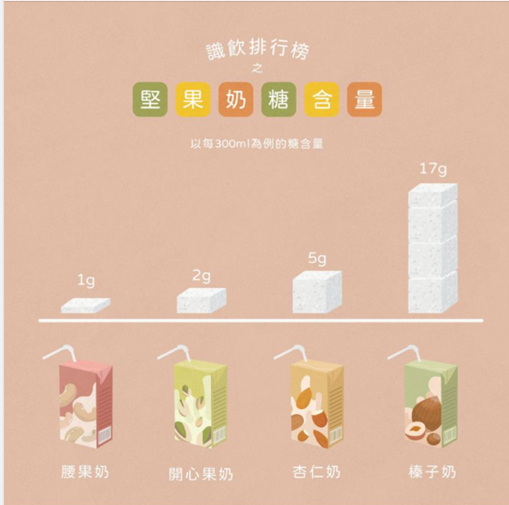
Smart Food Choices
A Healthy and Tasty Dish - Black Pepper Beef Tenderloin Dices with Apple
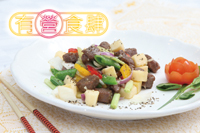
A dish prepared with vegetables and fruits can offer a great variety of nutrients, including vitamins, minerals and dietary fibre. Dietary fibre has cholesterol-lowering effects. It can also prevent constipation and increase satiety to help us avoid excessive food intakes. The dish introduced in this issue is prepared with apples. As the sweet taste and fragrance of apples will add a natural taste to food, the use of condiments can be reduced. Just add a pitch of black pepper and it will greatly enhance the flavour of the dish.
Interested readers can visit the “EatSmart Restaurant Star+” website of the DH (https://restaurant.eatsmart.gov.hk/eng/content.aspx?content_id=1030) for the recipe.
News on CFS
1. Commencement of 7th Term Consumer Liaison Group
The 7th term (current term) Consumer Liaison Group (CLG) came into operation in July 2021. Due to the epidemic, certificates of membership were posted to the correspondence addresses of the current-term members in batches at the end of October 2021.
The aim of establishing the CLG is to provide a platform to strengthen communication with the public on various food safety issues and collect suggestions and comments from them. The CLG seeks to gain an understanding of public knowledge and beliefs in food safety and consumers’ perceptions of risks associated with food for developing effective risk communication messages to meet public needs.
People who are interested are welcome to join the CLG and work together in promoting food safety. The application form can be downloaded from the website listed below:
https://www.cfs.gov.hk/clg
For enquiries, please contact Mr AU YEUNG at 2381 6275.
2. “Reduce Sugar Cravings” and “Look Out for the Hidden Salt”
The CFS strives to promote a healthy diet among members of the public. In August 2021, the CFS produced a new series of promotional leaflets on reduction of salt and sugar in food. It is conducive to enhancing public understanding of information on dietary practices with less salt and sugar.
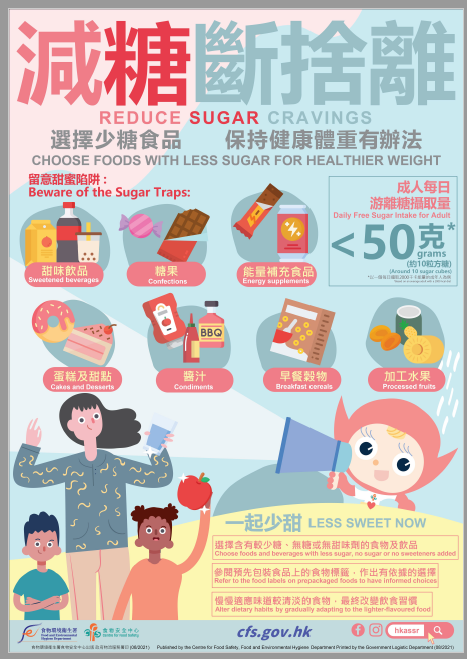
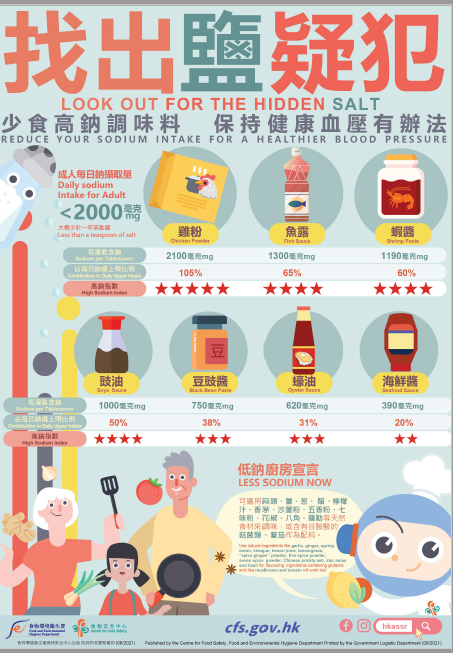
Leaflets
- Reduce Sugar Cravings
- Look Out for the Hidden Salt
The above leaflets are available on the CFS website:
https://www.cfs.gov.hk/english/programme/programme_nifl/files/Poster_Reduce_Sugar_Cravings.pdf
Free copies of the leaflets can be obtained from the Communication Resource Unit at Room 401, 4/F, Food and Environmental Hygiene Department Nam Cheong Offices and Vehicle Depot, 87 Yen Chow Street West, Sham Shui Po, Kowloon.
3. Safe Food at School Webinar 2021/2022
On 27 August 2021, the CFS held an online lecture before the commencement of the new school year to promote food safety awareness among schools and parents. The webinar was conducted by Dr Anna TANG Shiu-ping, Scientific Officer (Sugar Reduction), Mr Kenneth YIP King-sun, Scientific Officer (Technical Publication) and Chief Health Inspector (Hazard Analysis & Critical Control Point), who briefed school heads, teachers and parent group representatives on how to prevent food poisoning and prepare diets with suitable and sufficient nutrition for students. The topics included “Educating schoolchildren about high-risk foods and Five Keys to Food Safety”, “Low-salt and low-sugar diet” and “Prevention of food poisoning on campus”. Through this interactive seminar, the school personnel, parents and the CFS staff were able to exchange views on food safety matters directly.
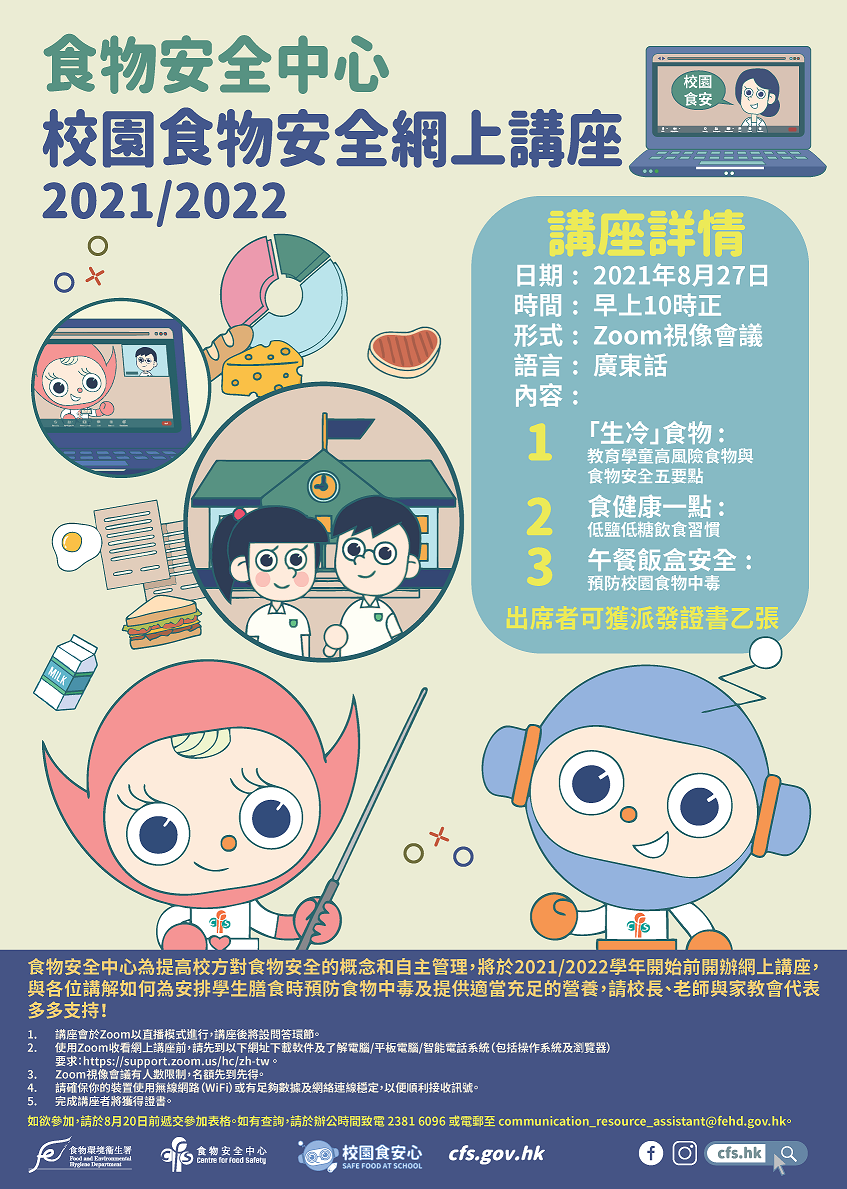

4. Briefing for Students of Bachelor of Science (BSc) Programmes in Community Health Practice and Public Health, Faculty of Medicine, Chinese University of Hong Kong (CUHK)
On 11 October 2021, the CFS held a video briefing for students of BSc programmes in Community Health Practice and Public Health Programmes, Faculty of Medicine, CUHK. During the briefing, the role of the Food and Environmental Hygiene Department in food safety surveillance and control in Hong Kong was introduced for students to have a preliminary understanding of the work of the CFS and to assist them in planning their career for professional development.
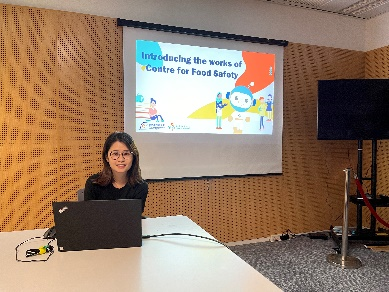
5. Hong Kong Brands and Products Expo 2021
The annual Hong Kong Brands and Products Expo will be held at Victoria Park from end of 2021 to early 2022. Same as previous years, the CFS will set up a booth during the Expo to promote food safety to the public. Publicity leaflets, pamphlets and souvenirs will be distributed. To approach food safety issues in a lively and interesting manner, the CFS staff will conduct on-stage interactive redemption games for the participants.
Having mentioned food safety, we must pay attention to the safety of consuming seasonal foods such as hotpots, “Poon Choi” and hairy crabs, which would probably appeal to you on autumn and winter days. In fact, autumn and winter are the peak seasons of viral gastroenteritis caused by norovirus. To minimise the risk of foodborne diseases, you are reminded to observe the following Five Keys to Food Safety:
- Choose (choose safe raw materials);
- Clean (keep hands and utensils clean);
- Separate (separate raw and cooked food);
- Cook (cook thoroughly); and
- Safe temperature (keep food at safe temperatures).
The CFS will share more food safety information with the public at the coming Expo. You are welcome to join us and learn more about food safety.
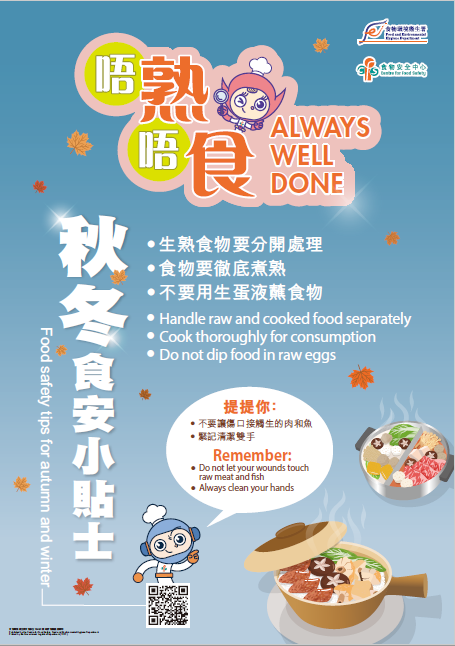
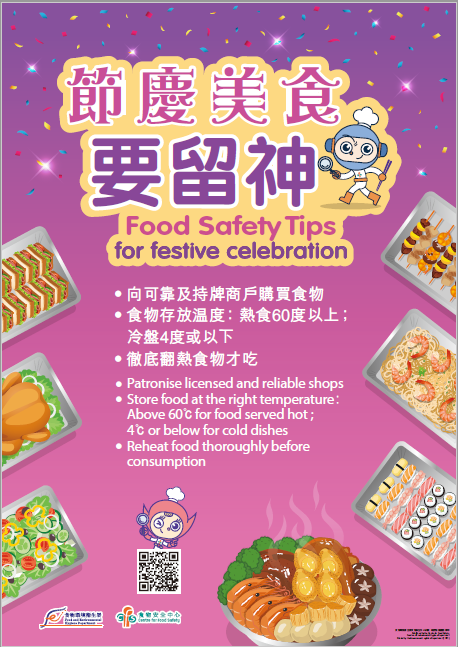
Ask Our Mascots

Wash the Husk of Longans. Do Not Peel Them with Teeth.
| Uncle CHU: | MUI, I’ve bought several catties of longans in the market. They are big, fresh and attractive in appearance. I’d taste some of them now. Hmm, it’s yummy! |
| MUI: | Wait a minute, Uncle CHU! The longans have not been washed. You just peeled them with your teeth. That’s scary! |
| Uncle CHU: | What’s scary about it? |
| MUI: | After harvesting longans, farmers or food manufacturers may add sulphur dioxide, that is SO₂, to longans to prolong their shelf life. SO₂ is a preservative used in a variety of foods. It is not uncommon to treat longans with SO₂. However, some people may be allergic to the chemical. They will develop symptoms such as shortness of breath, headache or nausea after exposure to it. It’s just not appropriate that you peeled longans with your teeth. |
| Uncle CHU: | How can I reduce the intake of SO₂ from consumption of longans? |
| MUI: | Don’t worry too much! SO₂ is soluble in water. You can remove a large portion of SO₂ from the fruit surface by washing longans thoroughly and rubbing them gently under running water. One more thing. Do not bite the husk of longans. Instead, remove the husk with clean hands before eating the fruit! |
| Uncle CHU: | That’s simple. Now let’s wash the longans and our hands and share the fruit together. |
| MUI: | Sure! |
Food Safety Quiz
1. Siu-mei chopped upon purchase should be consumed within ______ hours. (See “Feature Article”.)
2. Packaging gases can be considered a ____________ with unique functions in food processing which can slow down food spoilage and improve the shelf life of food products effectively. (See “Mascot ON in Lesson”.)
3. Frozen confections not properly handled during production and retailing are exposed to a high risk of contamination by microorganisms such as Listeria monocytogenes or _______________. (See “Diary of Mascot ON”.)
Answers:
1. four
2. food additive
3. coliform bacteria
Diary of Mascot ON
CFS Theatre - Soft Ice-creeeeeeam
It is cool to have a cup of soft ice-cream on a hot day. However, we must pay special attention to the production and selling of frozen confections. If we do not do so, there will be a high risk of food contamination by microorganisms such as coliform bacteria or Listeria monocytogenes.
In making soft ice-cream, the ice-cream pre-mix has to undergo heat treatment (commonly pasteurisation) to minimise microbiological hazards. The heat-treated mixture should be stored at a low temperature as soon as possible to prevent microbial growth. Nevertheless, contamination by microorganisms may still occur during handling and selling of soft ice-cream under the following circumstances:
! Improper storage temperature;
! Poor hygiene of soft ice-cream dispensing machines;
! Poor personal hygiene of dispensing machine operators.
To prevent the above, food premises supplying soft ice-cream should follow the Food Safety Advice for Manufacture and Sale of Frozen Confections:
🍦 Check the temperature of soft ice-cream dispensing machines regularly;
🍦 Arrange regular inspection, maintenance and repairs of soft ice-cream dispensing machines;
🍦 Provide regular training for staff members on operation of equipment (e.g. cleaning of soft ice-cream dispensing machines and food hygiene).
If you like soft ice-cream, remember to patronise reliable vendors and finish your ice-cream as soon as possible.
